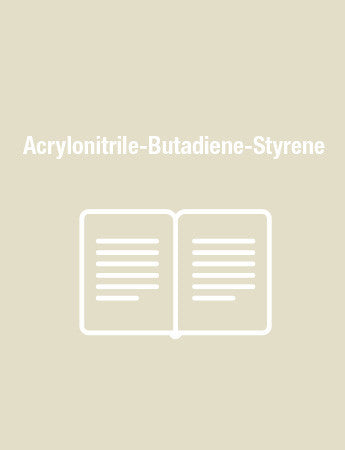Introduction to Plastics Recycling, 2nd Edition


Introduction to Plastics Recycling, 2nd Edition
Author: Vannessa Goodship
ISBN 978-1-84735-078-7
Soft-backed, 173 pages
ISBN 978-1-84735-078-7
Soft-backed, 173 pages
$120.00
Although recycling has a long history, it is only relatively recently that environmental protection and waste management issues have come to the forefront of both public and political awareness. Outside the fields of expertise, generally little is known about either plastics or their recyclability.
As in the successful first edition, this book provides straightforward information on plastic materials and technology, including the options for recycling plastics, with a special focus on mechanical recycling. It touches on all the major problems associated with recovering and recycling plastics at a level intended to be accessible to any reader with an interest in this field, whatever their background. It also looks at some of the broader issues surrounding successful waste management of plastics.
This new edition reflects the great strides that have been made to increase recycling rates worldwide in recent years. It considers the expansion of infrastructure in the UK to support plastic recycling and major achievements that have been made in gaining widespread public support and participation for recycling schemes; specifically the need to manage waste on an individual household level. Current issues surrounding council recycling of plastic bottles, and the practice of providing free plastic carrier bags by supermarkets, are also considered.
Biopolymers are expected to have a major impact on plastic markets in the future and therefore some of the issues of biodegradability versus recycling are expanded in this second edition, as is the wider context of life cycle analysis and legislation.
Key features...
As in the successful first edition, this book provides straightforward information on plastic materials and technology, including the options for recycling plastics, with a special focus on mechanical recycling. It touches on all the major problems associated with recovering and recycling plastics at a level intended to be accessible to any reader with an interest in this field, whatever their background. It also looks at some of the broader issues surrounding successful waste management of plastics.
This new edition reflects the great strides that have been made to increase recycling rates worldwide in recent years. It considers the expansion of infrastructure in the UK to support plastic recycling and major achievements that have been made in gaining widespread public support and participation for recycling schemes; specifically the need to manage waste on an individual household level. Current issues surrounding council recycling of plastic bottles, and the practice of providing free plastic carrier bags by supermarkets, are also considered.
Biopolymers are expected to have a major impact on plastic markets in the future and therefore some of the issues of biodegradability versus recycling are expanded in this second edition, as is the wider context of life cycle analysis and legislation.
Key features...
- Clear, easy to understand text
- Written for a broad audience both within and outside the polymer industry
- Good introduction to plastic materials and technology with useful illustrations
- Explains recycling terminology, technology, and material quality issues
- Up-to-date information on the plastics recycling infrastructure and recent developments
Reviewed.
About the 1st Edition
"...This book has been well written and great care is taken to make the information accessible. The lucid style and numerous internet based references should help any reader explore a promising area, and should, by design, lead to many returns."
Prof Roger C Hiorns
[DOI: 10.1002/pi.1471]
2004 Society of Chemical Industry. Polymer International 0959–8103/2004
Preface
1. Introduction
2. Back to Basics
2.1 Polymers
2.2 Thermoplastics
2.2.1 Polyolefins
2.2.2 Polyamides
2.3 Thermosets
2.4 The Formulation of Plastics
2.5 Why Does Recyclate Always Seem to be Black?
2.6 What Are Recyclates Used For?
3. The Effects of Processing on Thermoplastics
3.1 Rheology
3.2 Heat
3.3 Physical and Chemical Changes
3.4 Assessing Property Deterioration Caused by Repeated Cycling by Injection Moulding
3.5 Short-Term Mechanical Testing
3.5.1 Tensile Testing
3.5.2 Impact Testing
3.5.3 Tensile and Impact Testing of Recycled Expanded Polystyrene
4. Why Plastics Need to be Sorted
5. Reprocessing of Thermoplastic Recyclates
5.1 Contaminants
5.2 Recycling Techniques
5.3 Size Reduction
5.4 Washing
5.5 Identification and Sorting of Plastics
5.6 Agglomeration
6. Processing Techniques
6.1 Extrusion
6.1.1 Introduction
6.1.2 Compounding
6.1.3 Single-Screw Extruders
6.1.4 Twin-Screw Extruders
6.1.5 Co-Extrusion
6.2 Supply Chains for Compounds
6.3 Injection Moulding
6.3.1 Waste During the Injection Moulding Process
6.3.2 Co-Injection Moulding
6.4 Blow Moulding
6.4.1 Extrusion Blow Moulding
6.4.2 Injection Blow Moulding
6.5 Weld Lines
6.6 Film Blowing
6.7 Compression Moulding
6.8 Thermoforming
6.9 Processes for Incorporating Mixed Plastic Waste
6.9.1 Intrusion Moulding
6.9.2 Transfer Moulding
6.9.3 Sinter Moulding
6.10 Conclusion
6.11 Case Study: Plastic Lumber
7. Additives for Recyclates
7.1 Introduction
7.2 The Degradation of Plastics
7.3 Restabilisation of Recyclates
7.4 Testing the Effects of Stabilisers
7.4.1 Processing Stability
7.4.2 Heat Stability
7.4.3 Light Stability
7.5 Stabilisers
7.5.1 Thermal Stabilisation
7.5.2 Light Stabilisation
7.5.3 Additive Combinations for Specific Purposes
7.6 Modifying the Properties of Plastics Through Incorporation of Miscellaneous Additives
7.6.1 Degradable Plastics
7.6.2 Compatibilisers
8. Other Methods of Recycling and Waste Disposal Options
8.1 The Case of Thermosets
8.2 Chemical Recycling
8.3 Thermal Conversion Technologies
8.3.1 Pyrolysis
8.3.2 Hydrogenation
8.3.3 Gasification
8.4 Energy Recovery
9. Creation of a Recycling and Recovery Infrastructure for Plastics
9.1 Development
9.2 Design for Disassembly and Recycling
9.3 Developing Recyclate Markets
9.4 Logistics
9.5 Quality
9.6 Education
10. The Problem in Perspective: Europe
10.1 Case Study: Packaging
10.2 Integrated Product Policy
10.2.1 Waste Electrical and Electronic Equipment Directive (WEEE) 2002/96/EC
10.2.2 End of Life Vehicles Directive (ELV) 200/53/EC
10.3 Conclusion
11. Rise of the Biopolymers: Recycling versus Degradation
Abbreviations and Acronyms
Glossary
Index
About the 1st Edition
"...This book has been well written and great care is taken to make the information accessible. The lucid style and numerous internet based references should help any reader explore a promising area, and should, by design, lead to many returns."
Prof Roger C Hiorns
[DOI: 10.1002/pi.1471]
2004 Society of Chemical Industry. Polymer International 0959–8103/2004
Preface
1. Introduction
2. Back to Basics
2.1 Polymers
2.2 Thermoplastics
2.2.1 Polyolefins
2.2.2 Polyamides
2.3 Thermosets
2.4 The Formulation of Plastics
2.5 Why Does Recyclate Always Seem to be Black?
2.6 What Are Recyclates Used For?
3. The Effects of Processing on Thermoplastics
3.1 Rheology
3.2 Heat
3.3 Physical and Chemical Changes
3.4 Assessing Property Deterioration Caused by Repeated Cycling by Injection Moulding
3.5 Short-Term Mechanical Testing
3.5.1 Tensile Testing
3.5.2 Impact Testing
3.5.3 Tensile and Impact Testing of Recycled Expanded Polystyrene
4. Why Plastics Need to be Sorted
5. Reprocessing of Thermoplastic Recyclates
5.1 Contaminants
5.2 Recycling Techniques
5.3 Size Reduction
5.4 Washing
5.5 Identification and Sorting of Plastics
5.6 Agglomeration
6. Processing Techniques
6.1 Extrusion
6.1.1 Introduction
6.1.2 Compounding
6.1.3 Single-Screw Extruders
6.1.4 Twin-Screw Extruders
6.1.5 Co-Extrusion
6.2 Supply Chains for Compounds
6.3 Injection Moulding
6.3.1 Waste During the Injection Moulding Process
6.3.2 Co-Injection Moulding
6.4 Blow Moulding
6.4.1 Extrusion Blow Moulding
6.4.2 Injection Blow Moulding
6.5 Weld Lines
6.6 Film Blowing
6.7 Compression Moulding
6.8 Thermoforming
6.9 Processes for Incorporating Mixed Plastic Waste
6.9.1 Intrusion Moulding
6.9.2 Transfer Moulding
6.9.3 Sinter Moulding
6.10 Conclusion
6.11 Case Study: Plastic Lumber
7. Additives for Recyclates
7.1 Introduction
7.2 The Degradation of Plastics
7.3 Restabilisation of Recyclates
7.4 Testing the Effects of Stabilisers
7.4.1 Processing Stability
7.4.2 Heat Stability
7.4.3 Light Stability
7.5 Stabilisers
7.5.1 Thermal Stabilisation
7.5.2 Light Stabilisation
7.5.3 Additive Combinations for Specific Purposes
7.6 Modifying the Properties of Plastics Through Incorporation of Miscellaneous Additives
7.6.1 Degradable Plastics
7.6.2 Compatibilisers
8. Other Methods of Recycling and Waste Disposal Options
8.1 The Case of Thermosets
8.2 Chemical Recycling
8.3 Thermal Conversion Technologies
8.3.1 Pyrolysis
8.3.2 Hydrogenation
8.3.3 Gasification
8.4 Energy Recovery
9. Creation of a Recycling and Recovery Infrastructure for Plastics
9.1 Development
9.2 Design for Disassembly and Recycling
9.3 Developing Recyclate Markets
9.4 Logistics
9.5 Quality
9.6 Education
10. The Problem in Perspective: Europe
10.1 Case Study: Packaging
10.2 Integrated Product Policy
10.2.1 Waste Electrical and Electronic Equipment Directive (WEEE) 2002/96/EC
10.2.2 End of Life Vehicles Directive (ELV) 200/53/EC
10.3 Conclusion
11. Rise of the Biopolymers: Recycling versus Degradation
Abbreviations and Acronyms
Glossary
Index
Dr. Vannessa Goodship is a Senior Research Fellow at The University of Warwick. She worked in the plastics industry for fourteen years prior to working at Warwick and has acted as coordinator for the UK Polymer Recycling Network. She has now worked in the field of polymer processing for over twenty-four years and has published work on a variety of plastic related subjects.



